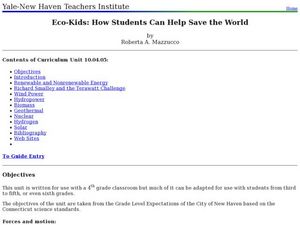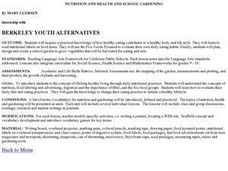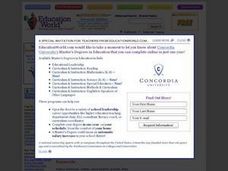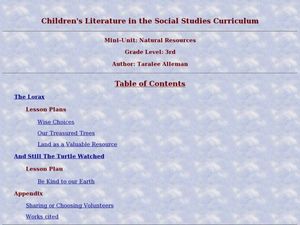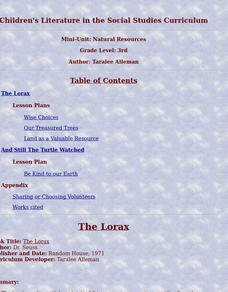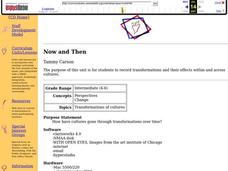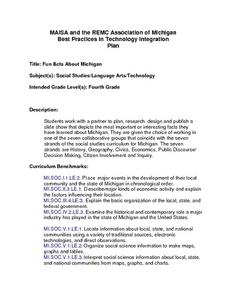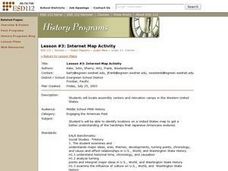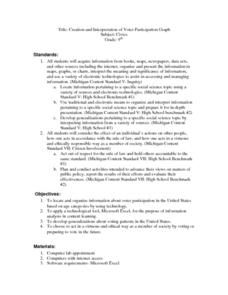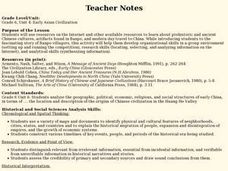Curated OER
Eco-Kids: How Students Can Help Save the World
Fourth graders identify the different types of renewable and nonrenewable energy sources. In this ecology instructional activity, 4th graders create models of wind mills and hydropower. They discuss the pros and cons of using alternative...
Curated OER
TORNADOES!
Third graders compare the parts of a real tornado with the parts of a tornado created in a demonstration, label "Tornado Alley" on their maps, and label the locations of famous tornado disasters on their maps.
Curated OER
Nutrition and Health and School Gardening
Students examine how healthy eating contributes to a healthy body and life style. They read nutritional labels on food items. They use the Five Foods Pyramid to evaluate their own eating habits. They plan, design, and create a school...
Curated OER
Native American Word Search
Students search this puzzle for the names of 20 of the most populous Native American groups in the United States today. They find in this word search puzzle the names of 20 of the 30 most populous Indian groups, according to the 1990...
Curated OER
Barbara Jordan
Young scholars examine the contributions made to our country by Barbara Jordan. They read and discuss the books "The Sneetches" and "Building a Bridge," write journal entries, participate in a discrimination simulation, create a class...
Curated OER
The Lorax
Third graders identify environmental problems. In this natural resources lesson plan students participate in several activities that support critical thinking about the environment and natural resources. The students write, list, and...
Curated OER
Land as a Valuable Resource
Students investigate why the soil is important to our lives. In this natural resources lesson, students have a farmer as a guest speaker. Students begin to understand how farmers use and protect our natural resource. Students write...
Curated OER
Shoot for the Moon
Second graders distinguish the different phases of the moon. In this astronomy lesson, 2nd graders study the history of its discovery and myths about its origin. They simulate how the moon's surface is illuminated by the sun.
Curated OER
The Sound of Music in Kenya
Students study Kenya's culture and see how people and things can be different and similar at the same time. They create a pictograph of objects from each culture that are used in similar ways and examine a few Swahili words.
Curated OER
Preparing and Planting the Garden
Students prepare to build and plant a garden. In this service learning lesson, students take all the necessary steps to prepare a community garden for planting and reflect on the experience.
Curated OER
Combating Corrosion
Study corrosion on bronze statues with a hands-on lesson. As pupils place a penny in water with salt, they observe the changes in the penny throughout a period of a week. They then analyze the pre-conservation and the post-conservation...
Curated OER
The Warrior Role in Greek Society
High schoolers are introduced to the various gods and goddesses in ancient Greek mythology. In groups, they use print and electronic resources to research the ways Greek culture has influenced the modern world. To end the instructional...
Curated OER
Now and Then
Young scholars record transformations and their effects within and across cultures. Students study the life of specific people in a former time period and then in the present time period. This teacher focused on the Winnebago tribe,...
Curated OER
The American Prairie
Students design an animal. In this prairie activity, students learn about physical and behavioral adaptation, locate the Great Plains on a map, and design an animal that would be perfectly adapted for life on the prairie. Students...
Peace Corps
Weather and Water in Ghana
Young scholars investigate the climate of their region. Students research statistics and conduct interviews. Young scholars take a virtual tour of Ghana and discuss its climate. Students consider water conservation and the role it plays...
Curated OER
Making Your Own Master Calendar
Ninth graders discuss time demands such as homework, family, and chores that occupy their free time. They discuss how to effectively manage their time. They write important information and activities on a calendar. They develop and...
Curated OER
Michigan Fun Facts
Fourth graders work with a partner to plan, rese,a rch design and publish a
slide show that depicts the most important or interesting facts they
have learned about Michigan. They are given the choice of working in
one of the seven...
Curated OER
Lesson #3: Internet Map Activity
Pupils label assembly centers and relocation camps on a given map of the United States in order to create a better understanding of the relocation experience of Japanese-American citizens and the distance that families had to move and...
Curated OER
Ecology
Students learn what the Kyoto Protocol is and examine the decision of the United States to not sign the agreement.
Curated OER
Creation and Interpretation of Voter Participation Graph
Ninth graders research information about voter participation in the United States based on age. They develop generalizations about voting patterns in the U.S and use Microsoft Excel to analyze the information.
Curated OER
Japaneses Internment: Lesson 1 of 4: Chronological Events Leading to Internment
Students examine facts about history of the Asians experience in America and identify patterns of Asian immigration in the United States. Students develop reasons specific Asian ethnic groups migrated to the United States and predict...
Curated OER
Banpo Village: Gone, But Not Forgotten
Sixth graders plan a trip to China and prepare yourself for the Banpo excavation site competition by studying prehistoric and ancient Chinese history.
Curated OER
Burial Practices and Memorials
Young scholars compare and contrast burial practices in ancient Egypt, the former Soviet Union, and the United States.
Curated OER
Folk Tales Thematic Unit
Second graders read different folk tales and discuss them. They are given a template of a letter and they are to write a friendly letter. Special education students are paired with advanced students to help them.


